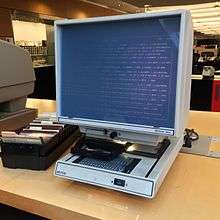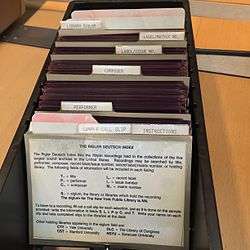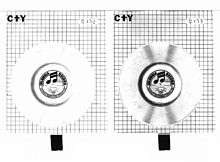Rigler-Deutsch Index
The Rigler and Deutsch Index of Recorded Sound, also known as the Rigler Deutsch Index, is a union catalog collocation of the U.S. holdings of 78 rpm records in the collections of the Library of Congress Motion Picture, Broadcasting, and Recorded Sound Division; the Rodgers and Hammerstein Archives of Recorded Sound at the New York Public Library; Belfer Audio Laboratory and Archive at Syracuse University; the Yale Collection of Historical Sound Recordings at Yale University; and the Stanford Archive of Recorded Sound at Stanford University.[1]

Microfiche Reader (right)
| Rigler Deutsch Index | |
|---|---|
 | |
| Housed at | Library of Congress New York Public Library Syracuse University Yale University Stanford University |
| Funded by | National Endowment for the Humanities |
History
The Rigler Deutsch Index was characterized as a cooperative, ground-breaking effort. Before its creation, sound recordings on the 78 rpm format were typically uncataloged and difficult to locate, as it was unclear where assets were held—although some collections were organized by label name, matrix number, etc.[2]
The Rigler Deutsch Index was created by the Associated Audio Archivists Committee (AAA)[3][4] of the Association for Recorded Sound Collections (ARSC) in 1984.[5] The AAA Committee is made up of elected members from each of the participating institutions. This committee conducts large research projects that provide solutions that are critically needed within the library and archive world, like the Rigler Deutsch Index project.[5]
As the institutions met to see if they had overlapping holdings—and cataloged records—the need for a shared solution became clear. Funding from the National Endowment for the Humanities was obtained to start a series of planning and organization meetings in October 1976. These meetings led to the publication of an initial planning study by the Association for Recorded Sound Collections that was conducted in 1978[6] along with Yale University's preliminary bibliography of journals that would be used in the project, also from 1978.[7] One outcome of this process was the creation of Rules for Archival Cataloging of Sound Recordings, as traditional cataloging methods did not meet all of the needs for recorded sound.[5] Another was the publication of A Discotopology Primer, that was used to guide cataloging and classification of the project.[8]
Funding was made easier by the fact that the University of Maryland had received a Ford Foundation grant and had successfully completed a project for its International Piano Archives, where they used an automated system to create microfilm and an index of its holdings.[5]
Philanthropist Lloyd E. Rigler provided financial support[9] with funds from his company with business partner and record collector Lawrence E. Deutsch, who pre-deceased the project.[10] A National Endowment for the Humanities grant and the Hewlett Foundation and the Ledler Foundation underwrote the project.[1][11]
Rigler became involved in the project out of an interest in creating a library of opera recordings. He had reached out to David Hall at what was then called New York Public Library's Rodgers and Hammerstein Archives, had learned of AAA's efforts, and agreed to provide matching funds for the Rigler Deutsch Index.[5]
Overview
Although it originated as 16mm microfilm, the Rigler Deutsch Index is typically accessed as a 1,250 microfiche resource,[12] and can be used to research approximately 615,000 recordings[11] ca. 1895 to the mid-1950s.[13]
The Rigler Deutsch Index allows patrons to locate sound recordings at the six participating institutions. It is an index of many records that have not been cataloged.[14]
The Rigler Deutsch Index is organized in six groups:[15]
- Label Name / Matrix Number / Issue Number / Author-Composer / Title / Performer / Archive Siglum
- Label Name / Issue Number / Matrix Number / Author-Composer / Title / Performer / Archive Siglum
- Author-Composer / Title / Performer / Label Name / Issue Number / Matrix Number / Archive Siglum
- Title / Author-Composer / Performer / Label Name / Issue Number / Matrix Number / Archive Siglum
- Performer / Author-Composer / Title / Label Name / Issue Number / Matrix Number / Archive Siglum
- Archive Siglum / Label Name / Issue Number / Matrix Number / Author-Composer / Title / Performer
The Archive Siglum is the library that holds the recording:
- CST: Stanford University – Stanford Archive of Recorded Sound
- CTY: Yale University – Yale Collection of Historical Sound Recordings
- DLC: The Library of Congress – Motion Picture, Broadcasting, and Recorded Sound Division
- NN: New York Public Library of the Performing Arts – Rodgers and Hammerstein Archives of Recorded Sound
- NYSU: Syracuse University – Belfer Audio Laboratory and Archive
Digitization

Efforts to digitize this resource as an asset available online were not initially successful.[16] The initial transfer of information to RLIN and then to OCLC resulted in a loss of bibliographic metadata and location information.
The original efforts involved taking two images of each side of the 78 rpm disc: one image was used to capture metadata from the disc label and the other image was used to capture the etched number (an alphanumeric string) that is found on 78 rpm discs. Information from these original images were then recorded and put on 16mm microfilm and/or microfiche in what is the current Rigler Deutsch Index. In total there were approximately 945 reels of 16mm film, representing 2.2 million disc images, that were put onto COM (computer output microfilm). Copies of this master set is held at the five repositories listed above.
Issues
While the information was successfully captured, the lack of context and training in cataloging recorded sound by those doing the input affected some data, so the Rigler–Deutsch Index is imperfect.[11] The microfilm format is not very sharp and easy to read.
Potential solutions
Efforts are underway at Stanford University to provide pathways between the original capture, the Rigler Deutsch Index, and other available resources as well as OCLC's databases in order to make the information available in a robust digital format.
References
- Kunst, Franz (2011). "Guide to the Rigler-Deutsch Index Computer Tapes ARS.0105" (PDF). Archive of Recorded Sound, Stanford University. Online Archive of California. Retrieved 1 June 2015.
- Bucknum, Mary Russell (October 2001). "Music Sound Archives in the United States". Fontes Artis Musicae. 48 (4): 381–390. ISSN 0015-6191. Retrieved 1 June 2015.
- "Associated Audio Archivists (AAA) Committee (ARSC)". Association for Recorded Sound Collections. Retrieved 1 June 2015.
- Hamilton, David (October 1996). "Knights of the Grail:The Association for Recorded Sound Collections is Devoted to Safeguarding the Sounds of the Past". Opera News. 61 (4): 26–28. ISSN 0030-3607. Retrieved 1 June 2015.
- McKee, Elwood (1988). "ARSC/AAA, Fifteen Years of Cooperative Research" (PDF). ARSC Journal. 20 (1): 3–13. Retrieved 1 June 2015.
- Bowles, Garrett H. (28 August 1978). "A union catalog of commercially issued pre-:LP" classical music and spoken word sound recordings : a planning study". Stanford University. Association for Recorded Sound Collections. Retrieved 1 June 2015.
- Warren Jr., Richard (1978). "A Preliminary Bibliography of Published Basic Source Materials and Guides to Dates of Recording for Pre-LP Classical Music and Spoken Word Sound Recordings" (PDF). ARSC Journal. 10 (2/3): 163–166. Retrieved 1 June 2015.
- Eick, Barbara; Wolff Pritchard, Gretchen; Warren, Jr., Richard (1981). "A Discotopology Primer" (PDF). ARSC Journal. 13 (1): 4–19. Retrieved 1 June 2015.
- Saxon, Wolfgang (13 December 2003). "Lloyd E. Rigler, 88, Industrialist and Backer Of a Variety of Arts Groups Across the U.S." The New York Times. Retrieved 1 June 2015.
- "Lloyd E. Rigler's Vision". Classic Arts Showcase. Retrieved 1 June 2015.
- Koprowski, Richard (March 1986). "Rigler and Deutsch Record Index". Notes. 42 (3): 535–537. doi:10.2307/897333. JSTOR 897333.
- "78rpm Recordings: The Rigler Deutsch Index". New York Public Library. Retrieved 1 June 2015.
- Yale University Library (31 July 2006). "Researching a Topic in Four Easy Steps: The Historical Sound Recordings Collection". Yale University. Retrieved 1 June 2015.
- "Recorded Sound Section – Motion Picture, Broadcasting and Recorded Sound Division: National and International Catalogs". Library of Congress. Retrieved 1 June 2015.
- Associated Audio Archives Committee (1984). "Final Report on Project RC-*1734-81: "A Survey of 'Pre-LP' Sound Recordings" "The Rigler and Deutsch Record Index"" (PDF). Stanford University. The Association for Recorded Sound Collections, Inc. Retrieved 1 June 2015.
- Lorimer, Nancy (January 2012). "Unlocking Historical Audio Collections: Collaborative Cataloging and Batch Searching of 78 rpm Recordings". Technical Services Quarterly. 29 (1): 1–12. doi:10.1080/07317131.2011.597682.
External links
| Wikimedia Commons has media related to Rigler Deutsch Index. |
